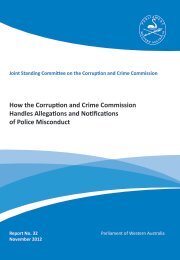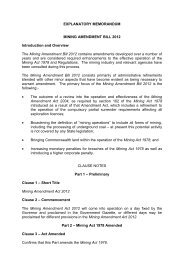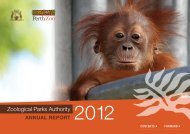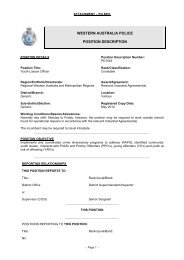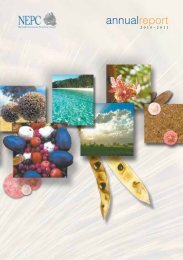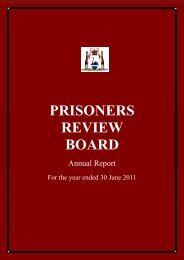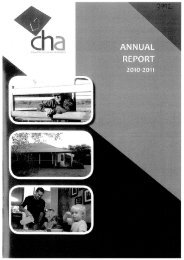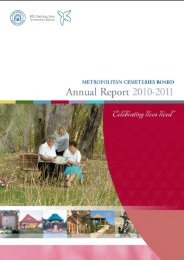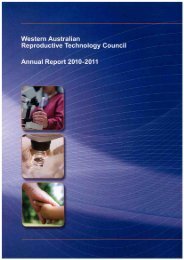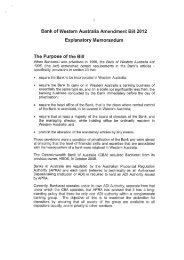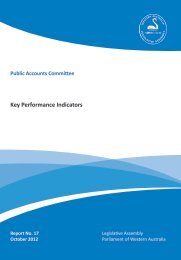Challenger TAFE | Annual Report 2006 - Parliament of Western ...
Challenger TAFE | Annual Report 2006 - Parliament of Western ...
Challenger TAFE | Annual Report 2006 - Parliament of Western ...
You also want an ePaper? Increase the reach of your titles
YUMPU automatically turns print PDFs into web optimized ePapers that Google loves.
Table 8.18 Total Indigenous Students (Certifi cate III Level and above)<br />
<strong>Challenger</strong> <strong>TAFE</strong> | <strong>Annual</strong> <strong>Report</strong> <strong>2006</strong> 47<br />
Year Target Actual % Target % Actual<br />
2004/5 206<br />
2005/6 232 224 12.60 8.7<br />
<strong>2006</strong>/7 237 261 2.15 26.7%<br />
2007/8 252 6.32<br />
2008/9 258 2.38<br />
Explanation: Apprenticeships and Traineeships form an important sub category <strong>of</strong> the Indigenous student group undertaking<br />
employment related qualifi cations.<br />
In <strong>2006</strong>, increases in Apprenticeships and Traineeships at Certifi cate III level and above were achieved in Information Technology,<br />
Retail, Business & Offi ce Administration, Engineering, Automotive & Construction and Horticulture & Science. Numbers in the<br />
remaining industry areas remained as for 2005.<br />
Table 8.19 Indigenous Apprentices and Trainees (Certifi cate III Level and above)<br />
2005 <strong>2006</strong><br />
Indigenous Trainees Apprentices Trainees Apprentices<br />
Information Technology, Retail, Business & Offi ce<br />
Administration<br />
1 7<br />
Engineering, Automotive & Construction 1 20 28<br />
Horticulture & Science 3 6 5 5<br />
Hospitality, Hairdressing, Beauty, Fashion & Human<br />
Services<br />
7 7<br />
Maritime, Transport & Distribution 2 2<br />
Total 7 33 14 40<br />
<strong>Challenger</strong> <strong>TAFE</strong> Improvement Process<br />
The <strong>Challenger</strong> <strong>TAFE</strong> improvement process conducts and collates the results from students’ evaluation <strong>of</strong> their training<br />
experiences.<br />
Explanation: Students are asked to rank their experiences on a scale <strong>of</strong> 1 to 5 in four areas <strong>of</strong> their learning experience at<br />
<strong>Challenger</strong> <strong>TAFE</strong>. These areas are: Unit Content; Delivery: Assessment; and Resources.<br />
Objective: The feedback obtained by this process is used to improve training delivery and assessment in line with the students’<br />
expectations. It also allows College management to recognise staff contribution to achieving the College goals, where this has<br />
been recognised by students.<br />
The volume <strong>of</strong> evaluations returned by students while declining overall (2002-<strong>2006</strong>), experienced an increase from the number<br />
received in 2005. The College’s target <strong>of</strong> evaluating 10% <strong>of</strong> delivery was achieved. During <strong>2006</strong> a new electronic facility was<br />
introduced which allows students to submit their feedback on line and may be a contributing factor in the upswing in the number<br />
<strong>of</strong> feedback forms received. The electronic process has provided managers with timely access to feedback. This has enabled<br />
<strong>Challenger</strong> <strong>TAFE</strong> to address concerns more quickly.



